What has the Internet ever done for art?
The Google Art Project and the Missing Net Art Movement
The Google Art Project launched this week, bringing the technology of Google street view indoors to internationally renowned gallery spaces. Viewers can now browse classic collections in hyper-real gigapixel quality, without having to leave the comfort of their computer chair.
The project creates a whole new world, perhaps even a Second Life and, soon, we'll all stop visiting art galleries and encountering reality in virtual worlds. This all sounds very familiar. The future has arrived - again. Or has it?
There is no denying that the experience of Google Art is incredibly engaging or that it provides a unique art experience that most people could never enjoy. This is due largely to the fact that most highly valuable paintings always remain slightly out of our reach, positioned behind glass, wires or, in the case of the Mona Lisa, behind a beautifully carved wooden fence, a safe distance from the pollution of human touch or even breath.
Through the Google Art Project, browsers can zoom into every tiny millimeter of a painting and even see the cracks in the paint, perhaps discovering aspects of the work that were previously impossible to perceive. It brings a whole new layer of experience to art appreciation and this is its primary achievement. As well, there's a good chance that this will improve the footfall at these galleries rather than lead people to stay at home.
Yet, what troubles me about the Google Art project is the massive disconnection between which art it delivers and what has taken place in the art world over the last two decades. One might have thought that a company that has been defined by the Internet era would place some value on the artists that have shaped its community. Admittedly, a lot of these people are not particularly enamored with the success of commercial web giants like Google. Still, an acknowledgement of the way that the Internet has been defined by such artists as Heath Bunting, Jodi or any number of new media artists http://en.wikipedia.org/wiki/Media_art would have been an enterprising gesture.
Of course, Google may not want to celebrate the work of such artists as Steve Lambert, whose collaborative 'AddArt' project replaces all advertisements in web browsers with art work. But it really should. Such interventions are what has made the Internet so engaging over the years. Indeed, time and again, its value is evidenced by such politically charged matters, as evidenced by WikiLeaks or the recent coverage of the Egyptian uprising.
In addition to simply championing classic art works, Google could bring the cutting edge of art innovation to art lovers, re-defining how people make sense of art and influencing what people are willing to identify as beauty.
Most new media art does not tend to reach the kinds of people that typically frequent the galleries assembled in the Google Art Project. One exception is taking place in Liverpool this month, a collaboration between the UK's new media art institution FACT and TATE Liverpool. In a joint exhibition celebrating the pioneering media artist Nam June Paik, the two institutions are doing the kind of work that Google Art Project could be doing - bringing avant garde work into the mainstream art territory. These two institutions - at opposite ends of Liverpool, the host city for this year's international Media Art History conference - are even connected by Peter Appleton's green laser beam, which stretches high across the city, generating a powerful symbolic message about the need for art to work harder to foster new audiences.
The web is a wonderful medium through which boundaries collapse, not just physical, but also sociological, political and aesthetic. Google's art project is out of sync with the values of the digital revolution. Moreover, the absence of new media artists means that it may not be long before hackers find a way to add graffiti to these digital collections or simply seek use them to make statements about what art experiences ought to offer in the 21st century. Certainly, it should include what the GAP presently offers, but it can go so much further at changing our relationship to art, in the way that Google's Search Engine has changed our relationship to information.

